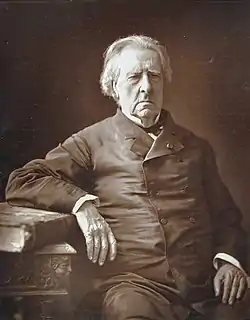Baron Isidore Justin Séverin Taylor
Isidore Justin Séverin Taylor was born in Brussels on 5 August 1789 and died in Paris on 6 September 1879. He was closely associated with the development of French theatre, a noted traveller and author, and a philanthropist.

Life and career
Isidore's father Hélie Taylor was English born and took French nationality. His mother was the Belgian Marie-Jacqueline Walwein (from what was then the Austrian Netherlands). Originally destined for a military career, the young man neglected this in favour of travelling about Europe and later the Near East. Among the fruits of his travels was a series of books on the French regions, Voyages pittoresques et romantiques dans l'ancienne France (1820–63), the nearly 7000 lithographs in which were the first to catalogue the French artistic patrimony.[1] Another book, La Syrie, l'Égypte, la Palestine et la Judée (Paris, 1839), was illustrated with the author's watercolours, two of which are now in the collection of the Victoria and Albert Museum.[2]
George Borrow describes meeting Taylor in his The Bible in Spain. "He has visited most portions of the earth, and it is remarkable enough that we are continually encountering each other in strange places and under singular circumstances. Whenever he descries me, whether in the street or the desert, the brilliant hall or amongst Bedouin haimas, at Novgorod or Stambul, he flings up his arms and exclaims, 'O ciel! I have again the felicity of seeing my cherished and most respectable B…'".[3] Ennobled in 1825 by King Charles X, he was by this time collecting Spanish art on behalf of the new French King Louis Philippe I, who made him a Commissioner of Art in 1838. These paintings constituted the then named Spanish gallery of the Louvre.[4][5]
Previously, he had been very active in the theatrical world and was made Royal Commissioner of the Theatre Francaise between 1825-38. During this period he used his position to encourage the production of Romantic drama. Among those he helped was Alexandre Dumas, who dedicated to Taylor his first successful play, Henri III et sa cour (The court of Henry III, 1829). Taylor himself authored plays with a Levantine background, Ismael et Maryam, ou l'arabe et la chrétienne (The Arab and the Christian, 1821) and La fille de l'Hébreu et le chevalier du temple (The Jewess and the Templar, 1823) and co-authored with Charles Nodier an adaptation of Charles Maturin's successful drama, Bertram ou le pirate (1821).
From the 1840s he began his philanthropic activity by setting up a series of mutual societies for members of the artistic professions that have continued to this day as the Taylor Foundation. In recognition of his work he was elected to the Académie Française in 1847, named a senator of the Second Empire in 1869 and made an officer of the Legion of Honour in 1877.
Artistic representations

| Wikimedia Commons has media related to Isidore Taylor. |
After his death, Taylor was buried in the Père Lachaise Cemetery with a memorial statue by sculptor Gabriel-Jules Thomas.[4] A decorative bust by Tony Noel (1845-1909) was also erected on behalf of the Taylor Foundation on the Boulevard Saint Martin.[6] Both of these show the baron in old age. There were attractive earlier portraits of him by Jean Alaux when he was 22,[7] and by Federico de Madrazo y Kuntz at the age of 44. The latter is a three-quarters bust that pictures him in his official uniform in 1838.[8] He also figures in the crowded canvas of Edouard Manet's Music in the Tuileries (1862). Taylor is pictured in the mid-foreground to the left with his cane beneath his arm as he talks to Charles Baudelaire and Theophile Gautier.[9]
References
Much of the information is based on the article in the French Wikipedia.
- M. Christine Boyer. The City of Collective Memory, MIP Press 1996, pp. 238-40
- Victoria & Albert Museum website
- The Bible in Spain (1923 edition ch.15, p.222
- "TAYLOR Isidore Justin dit le Baron". appl-lachaise.net. Retrieved 2018-01-21.
Louis Philippe le charge en 1835 d'acquérir des tableaux en Espagne pour permettre l'ouverture de la Galerie espagnole du Musée du Louvre en 1838.
- "Taylor, barón Isidore-Justin" (in Spanish). Museo del Prado. Retrieved 2018-01-21.
En el mismo año se abrió en París la Galería Española de Luis Felipe, con unas cuatrocientas obras españolas. Hasta su venta final en 1853, aquella colección ejerció una influencia considerable sobre el gusto artístico de Francia, aunque también recibió críticas acerbas en la prensa. Gran parte del texto de Taylor sobre el Real Museo de Madrid constituye realmente una vindicación de la Galería Española de París.
- Photographs of both are on the Statues de Paris site
- Association des artistes peintres, sculpteurs, architects, graveurs, dessinateurs
- L’Histoire par l’image
- Therese Dolan, Manet, Wagner, and the Musical Culture of Their Time, Ashgate Publishing 2013, pp.93-6